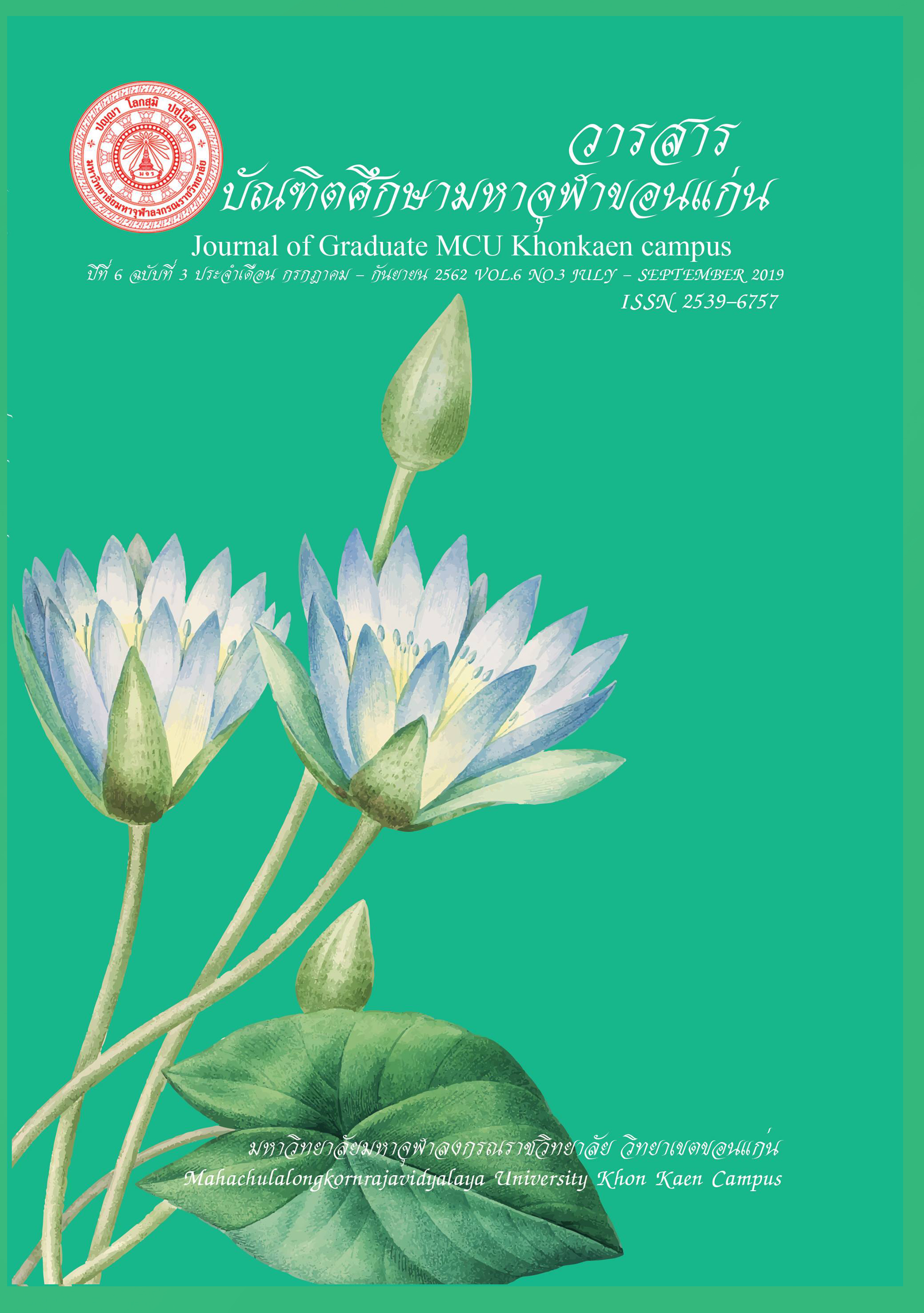Enhancing cultural tourism management by creative communities in the group Roikhansarasin Province
Main Article Content
Abstract
The purpose of this research is to explore cultural attractions by creative communities. Develop strategies to enhance cultural tourism management by communities To suggest ways to raise the level of cultural tourism management by creative communities in the Roikhansarasin Provincs is a qualitative research (Qualitative Research), a way to raise the level of cultural tourism management by creative communities in the Roikhansarasin provinces (SWOT) and to be analyzed (TOWS Matrix). Culture in the Roikhansarasin Province Group. The population is related to the tourist attraction. In the Roikhansarasin Province Group, can be classified into 3 groups: 1) Government representatives Related to the Roikhansarasin Province Group 2) expert group Related to Tourism in the Roikhansarasin Province in the province
The research found that
Analysis results From network partners Have a role to be involved Expressing the ownership of hope from doing this will get this In order for the organization to support the important part of the government policy Tourism promotion by the community has policies in every province as unity, unity, such as Kalasin province has organized the Phra That Na Khu event. In order to show ownership, made with pleasure Do not get tired. And having a core that is needed and showing the importance of the show With community leadership Such as adopting the guiding principle or guiding the community and having a service mind, but what attracts the mind or attraction is like Natural resources The story of the ancient story of the new creation of the new village of Nong Hin. Give alms to teerowahina Can be a Lanark In conclusion, the model for enhancing cultural tourism management by the community is
- Egoi Autna, a self-sufficient jar The community must have the potential to be self-reliant. Before realizing, there is hope that doing this must be done. In the community, there is a tourist attraction that attracts tourists. It has its own identity and leadership. There are leaders with knowledge and folklore. Have ancient culture There is a way of community, having good internal and external PR management. Therefore will enhance the management of cultural tourism by sustainable communities
- Market leading production That tourists want to travel to develop tourist attractions in that community by seeing market developments before production, such as manufacturers, taking into account market demand and revenue If not looking for a tourist market, there are no visitors. Therefore has an opinion that If the market is not needed, the producer will not be able to produce it. Therefore, cultural tourism by the community Therefore develop tourism by themselves and adhere to the principles of tourism advertising according to market demand Tourism needs to know how tourists want it. And then come to produce as the tourists want For example Today, there are coffee shops that look good in the country style. There are customers visiting the store to take pictures and the result is that customers come to buy coffee because they want to take pictures. For example, a group of tourists is a group of young people in the community.
- Support for promotion and support Overall, making it a frequent addiction Will make you weary Seek strange new things because new items are created to attract the market, lead production. Longing for the old, the back Ancient selling By summarizing tourism, a learning resource that is not a single season, ask for activities to come every month, such as Ban Nong Hin, there are fourteen twelve heat-traditions traditions. Tourism management, the network must have 7 days 7 tourism, ie Nakhon Phanom, Wai Phra 9, Phra That
3.1 There are hundreds of tourism networks. Sin is an ancient tourism.
3.2 Binding the story to Story
3.3 The actors and methods of reinforcement between the states are supporting the community as an Isan language process. If not sparked, the light will not have an aura. Which communities are trying to push themselves up?
- Tourism management process The supplementary agency must have both science and art in promoting and developing Would like to conclude that it is the development of tourism management to raise the level of tourism in upgrading tourism management so that it will be useful in improving the level of cultural tourism management by the community forever.
Article Details
References
การท่องเที่ยวแห่งประเทศไทย. (2554 ก). แผนพัฒนาและส่งเสริมการท่องเที่ยวของการท่องเที่ยว แห่งประเทศไทย. เข้าถึงได้จาก: http://thai.tourismthailand.org/tourismthailand_index/th/
การท่องเที่ยวแห่งประเทศไทย. (2540). โครงการเพื่อกำหนดนโยบายท่องเที่ยวเพื่อรักษาระบบนิเวศ. กรุงเทพฯ : การท่องเที่ยวแห่งประเทศไทย.
การท่องเที่ยวแห่งประเทศไทย. (2551). จุลสารการท่องเที่ยว TOURISMJOURNAL, ฉบับที่ 4 : ตุลาคม - ธันวาคม 2551, หน้า 7
กิตติชัย เจริญชัย. (2548). แนวทางการพัฒนากลยุทธ์ทางการตลาดและศักยภาพการท่องเที่ยว เพื่อสัมผัสวัฒนธรรมชนบท (โฮมสเตย์) บ้านซะซอม ตําบลนาโพธิ์กลาง อําเภอโขงเจียมจังหวัดอุบลราชธานี. วิทยานิพนธ์ ปริญญาบริหารธุรกิจมหาบัณฑิต มหาวิทยาลัยขอนแก่น
กษมา ประจง. (2546). ผลกระทบของการท่องเที่ยวต่อชุมชน: กรณีศึกษาชุมชนบ้านศรีฐาน ตำบลศรีฐาน อำเภอภูกระดึง จังหวัดเลย. วิทยานิพนธ์ศิลปศาสตรมหาบัณฑิต, มหาวิทยาลัยราชภัฏเลย
โครงการศึกษาเพื่อจัดทำแผนปฏิบัติโครงการศึกษาวิจัยการจัดการมนุษย์กับสิ่งแวดล้อม. (2541). โครงการศึกษาเพื่อจัดทำแผนปฏิบัติการ เพื่อฟื้นฟูทรัพยากรการท่องเที่ยวในพื้นที่อนุรักษ์ (เชียงใหม่). โครงการศึกษาวิจัยการจัดการมนุษย์กับสิ่งแวดล้อมภาคเหนือ บัณฑิตวิทยาลัย มหาวิทยาลัยเชียงใหม่
จารุเชฏฐ์ เรืองสุวรรณ. (2547).การประเมินคุณภาพการจัดการการท่องเที่ยวชุมชนยี่สาร อำเภออัมพวา จังหวัดสมุทรสงคราม. วิทยานิพนธ์วิทยาศาสตรมหาบัณฑิต สาขาวิชาอุทยานและนันทนาการ, บัณฑิตวิทยาลัย มหาวิทยาลัยเกษตรศาสตร์
จุฑามาศ จิเจริญ (2545). บทบาทที่ปฏิบัติจริงและบทบาทที่คาดหวังในการพัฒนาการท่องเที่ยว ศึกษาเฉพาะกรณี องค์การบริหารส่วนตำบล จังหวัดเลย . เลย : วิทยานิพนธ์ สถาบันราชภัฏเลย
สัญญา เคณาภูมิ. (2558). “การสร้างกรอบแนวคิดการวิจัยโดยใช้ทฤษฎีจากฐานราก” วารสารวิจัยและพัฒนา วไลยอลงกรณ์ ในพระบรมราชูปถัมภ์ สาขามนุษยศาสตร์และสังคมศาสตร์ ปีที 10 ฉบับที่ 3 : กันยายน-ธันวาคม 2558
องค์การบริหารการพัฒนาพื้นที่พิเศษเพื่อการท่องเที่ยวอย่างยั่งยืน (องค์การมหาชน). (2557). การจัดการการท่องเที่ยวสร้างสรรค์เชิงวัฒนธรรม : http://www.dasta.or.th/creativetourism/th/article/156-notice4.html
องค์การบริหารพื้นที่พิเศษเพื่อการท่องเที่ยวอย่างยั่งยืน (องค์การมหาชน). (2558). การท่องเที่ยวเชิงสร้างสรรค์คืออะไร. [Online] http://www.creativetourism.com/c_main/about
อุดมศักดิ์ แนวจิตร.(2544).ความคาดหวังและความพึงพอใจของนักท่องเที่ยวต่อการจัดการสภาพแวดล้อมเพื่อการท่องเที่ยวเชิงนิเวศ : กรณีอุทยานแห่งชาติแจ้ซ้อน. วิทยานิพนธ์ ศิลปศาสตรมหาบัณฑิต มหาวิทยาลัยเชียงใหม่
Adhikary, M. (1995). Management of Ecotourism. Bangkok: Srinakarinwirot University.
Bovee, L.C. , & Others. (1993). Management. New York: McGraw-Hill
Cohen, E. 1979. A Phenomenology of Tourist Experience , Sociology, 13, p. 179-201
Collier and Harraway.(1997). Principler of Tourism. Auckland: Longman Paul Ltd.,
Collier, A. & Harraway, S. (1997). Principle of Tourism. Auckland: Longman
Middleton, Victor T.C. 1994. Marketing in Travel and Tourism. 2nd ed. Oxford: Heinemann Professional Publishing, p.54.
Perreault, W. D., Dorden, D.K. and Dorden, W.R. (1979). A Psychological Classification of Vacation Life-styles, Journal of Leisure Research, 9, p. 208-224
Swarbrooke, John and Susan Horner. (1999). Consumer Behavior in Tourism. Great Britain : Butterworth-Heinemann,

